Yes, I thought that would get your attention. Of all the things on a boat that can break, the rudder is particularly difficult to fix – being somewhat under water.
So, this was the rudder stock – just as important but you don’t get wet.
To clarify, by “rudder stock”, I mean the massive bronze casting which connects the rudder shaft to the tiller by means of a stout pair of jaws and a 10mm bolt. The whole thing is hugely over-engineered – but then there are times when there is so much strain on it that even the strongest helmsman tends to get dragged across the cockpit like a toddler being removed from Sainsbury’s in the middle of a tantrum.
So, I was a bit surprised when this happened.
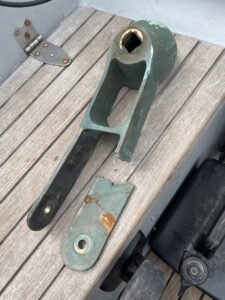
Also, maybe not so surprised, since it has happened before – if you want to read about that, come back at the end and have a look at https://www.oldmansailing.com/getting-to-the-jester/
and, if the picture seems familiar, that is from the same occasion. I forgot to take a new one.
The man who brazed it back together that time, assured me it would be as strong as ever – but maybe not, since this time it broke in exactly the same place.
Last time, I didn’t consider it my fault. This time it was: I had met an old boy on an old gaffer in Falmouth (yes, one of the many) who assured me that if I set a double-reefed mainsail behind my twin headsails in the trade winds, and steered with the wind just a little on the quarter, the boat would not roll incessantly for three weeks and leave me craving to get off and sit under a palm tree at the other end.
It worked – but the strain on the steering was tremendous – especially when those 28kt squalls came blasting through at three o’clock in the morning.
Although, it must be said that it was during the after-lunch down-time that I began to wonder why the boat was heading for Antarctica.
The best thing about this was that I knew exactly what to do – after all, hadn’t I done it all before? Without missing a beat, I lashed the broken side together with a 17mm spanner (there’s a 17mm nut on that side), got the boat sailing again and carried on as if nothing had happened – apart from the tiller waggling a bit and the Aries working overtime to catch up.
Four days later, the other side broke – and this was most definitely my fault. Why hadn’t I lashed another spanner (18mm to starboard) on that side just in case?
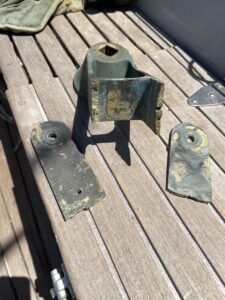
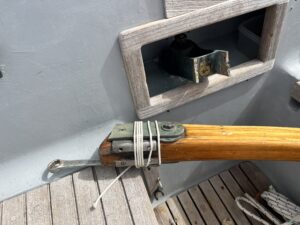
For the next 12 days, I didn’t make any more mistakes. Indeed, I consider those 1,486 miles to be among the most significant in all the annals of seafaring. Day after day, as the great Trade Wind rollers swept Samsara ever westwards and, each midday, I wrote carefully in the log: Wind: E5-6 occ7”, I became the world’s greatest living expert on how to hold your steering together with string.
This is what it looked like by the end.
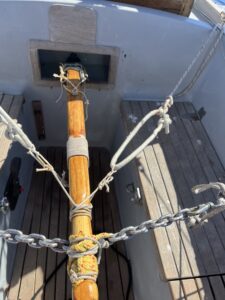
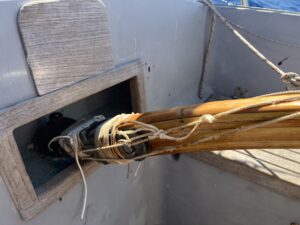
Key:
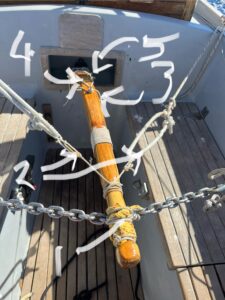
- The Aries adjustment chain was lashed to the tiller as far forward as possible. This pulled the tiller back and helped it remain engaged with what was left of the rudder stock.
- These two lines were made up of 8mm polyester and 8mm doubled shock cord. Made off at the stern cleats and lightly tensioned when the tiller was amidships, they proved to be worth their weight in gold. When the Aries pulled the tiller to starboard, the port shock cord exerted an increasing tension backwards on that side and helped keep the linkage straight.
- Two lines from the autopilot pin to the aft ends of the two spanners bracing each side of the casting. Without these, the spanners tended to work backwards and disengage from the nuts.
- Here, a single piece of line around the shafts of the two spanners and over the top of the tiller stopped it dropping down as it worked.
- These are the four main lashings bracing the spanners against the broken casting and holding the whole thing together. You need to have two at each side of the break so that you can untie them one at a time for tightening. In the beginning, this needed to be done two or three times a day. Towards the end, they would last several days – presumably as the line stretched to its limit. Eventually, it would get chewed up and break (which is why every ship should carry miles and miles of 3mm line. If your rudder doesn’t break, you can always use it for messengers when removing the halyards ready for a hurricane).
Technical notes – Tying the lashing:
Although I earned my “Knots and Splices” badge in the Boy Scouts, I take issue with Lord Baden-Powell who advocated clove hitches to start and finish a square lashing. This does not allow for applying enough tension to something like a rudder stock.
Instead, I humbly propose the following:
Take 2m of 3mm line and tie a small bowline in one end, leaving a 100mm tail on the short end. Place the bight at the top of one side of the tiller and pass the long end underneath and back through the bight so that you can pull back in the opposite direction, using this purchase to increase the tension. Continue with this for as many turns as you deem necessary, maintaining the tension at every turn. Tie off to the end to the 100mm tail of the bowline using a reef knot (while playing hopscotch with your fingers to maintain the tension.)
Overall, it worked so well that I didn’t feel the need to rush into Spice Island Marine on Grenada to get it fixed immediately. Instead, I called in for a few days’ crawling the rum shops of Carriacou’s Tyrrel Bay. I felt I deserved it – after all, the bodged rudder stock steered us through the somewhat narrow and certainly lively pass north of Frigate Island and then kept a dead straight course between the anchored yachts while I stood on the foredeck yanking the chain out of its latest yoga position down in the locker.

Tyrrel Bay.
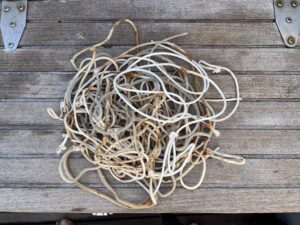
Of course, you do end up with this…
And now, some showing off: How about three headsails!
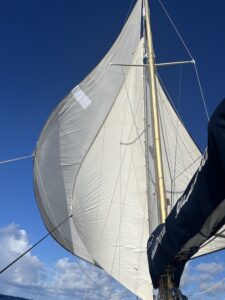
… actually, it didn’t make much difference.
And (not showing off), this was the biggest flying fish on deck in the morning:
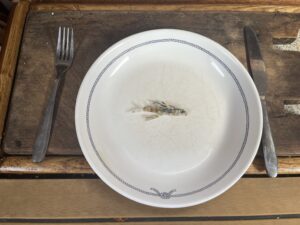
Finally, that link to the last time I broke the rudder: https://www.oldmansailing.com/getting-to-the-jester/
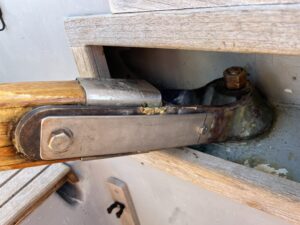
Better now
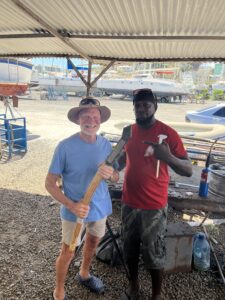
Thanks to Kenrick

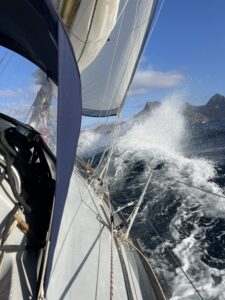
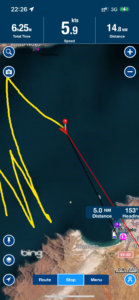
Proper Sailor!!!!
Great job John. I have an prefer the Hydrovane as it give you a spare ruder.
That’s a very good argument for the Hydrovane and I would certainly want one if I had wheel steering. My first Rival came with an Aries and so did this one so I suppose it was a question of “go with the flow”!
I believe that sailors are the most inventive of people simply because we have to make do with what is on board. Of course it is imperative to know where everything lives if possible!
As sister to John, I sailed with our family until I married a man who had designed his own 25 footer which we built outside Paris and then sailed to the Aegean in 1972 where she has remained. We invented all sorts of unique ways and means to solve problems (for example we measured and installed the mast and rigging from a bridge over the river Marne) and this characteristic has become so embedded it has proved useful many times throughout my life.
I really enjoy reading your blogs, thank you.
Goodness me you are so resourceful…just as well .
Thank you. I enjoy all your blogs.
You are a truly amazing mariner.
That casting hasn’t moved since last time it broke, still lying in exactly the same place on the cockpit locker… Or did you reuse the old picture?
Same old picture – forgot to take a new one until the other side broke.
Sounds as if you coped very well John ! Well done.